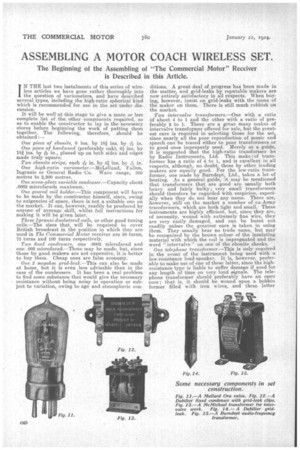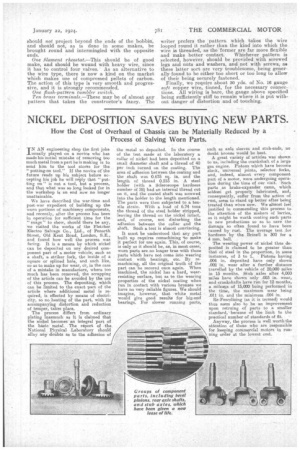ASSEMBLING A MOTOR COACH WIRELESS SET.
Page 24

Page 25

If you've noticed an error in this article please click here to report it so we can fix it.
The Beginning of the Assembling of "The Commercial Motor" Receiver is Described in this Article.
iN THE last two instalments of this series of wireless articles we have gone rather thoroughly into the question of variorneters, and have described several.types, including the high-ratio spherical kind which is recommended for use in the set under discussion.
It will be well at this stage to give a more or less complete It of the, other components required, so as to enable the constructor to lay in the necessary stores before beginning the work of putting them together. The following, therefore, should be obtained :— One piece of ebonite, 6 ins. by 184 ins, by ak in.
One piece of hardwocd (preferably oak), 61 ins. by 18-R ins, by iiin., planed up on both sides and edges made truly square.
Two ebonite strips, each 1,. in. by .ii ins. by * in.
One high-ratio variometer—McLelland, Fallon, Ingranie or General Radio Co. Wave range, 300 metres to 2,200 metres.
One seven-plate variable condenser.—Capacity about .0003 microfarmis maximum.
One geared coil holder. —This component will have to be made by the constructor himiself, since, owing to exigencies of space, there is not a suitable one on the market. It can, however, readily be produced by anyone of average skill, whilst full instructions for making it will be given later.
Three lgrantd duolateral coils, or other goad tuning coils.—The sizes that, will be required to cover British broadcast in the position in which they are used in The Commercial Motor receiver are 50 turns,
75 turns and 100 turns respectively. ,
Two fixed condensers, one .0003 rnicrofarad and one .002 microfarad.—These may be made, but, since those by good makers are not expensive, it is better to buy them. Cheap ones are false economy.
One 2 megohm grid-leak.—This can also be made at home, but it is even less advisable than in the case of the condensers. It has been a real problem to find some substance that would give the necessary resistance without being noisy in operation or subject to variation, owing to age and atmospheric con ditions. A great deal of progress has been made in the matter. and grid-leaks by reputable makers are now entirefy Satisfactory in all respects. When buying, however, insist on grid-leaks with the name of the maker on them. There is still much rubbish on the market.
Two intervalve transformers.—One with a ratio of about 4 to 1 and the other with a ratio of preferably 2 to 1. There are a great many makes of intervalve transformer offered for sale, but the greatest care is required in selecting those for the set, since nearly all the poor reproduction of music and speech can be traced either to poor transformers or to good ones improperly used. Merely as a guide,
i it s suggested that the high-ratio transformer be
by Radio Instruments, Ltd. This _ make transformer has a ratio of 4 to 1, and is excellent in all respects, although, no doubt, those by other leading makers are equally good. For the low-ratio transformer, one made by Burndept„ Ltd., takes a lot of beating. As a general guide, it may be mentioned that transformers that are good are usually both heavy and fairly bulky very small transformers should therefore be regarded with suspicion especially when they do not bear any name. There are, however, still on the market a number of ex-Army transformers, which are both light and small. These instruments are highly efficient. but, since they are, of necessity, wound with extremely fine wire, they are very easily damaged, and can be burnt out readily unless the greatest care is taken in using them. They usually bear no trade name, but may be recognized by the brown colour of the insulating material with which the coil is impregnated and the word "intervalve" on one of the ebonite cheeks.
One telephone transformer—This is only required in the event of the instrument being used with. a low-rethstance loud-speaker. It is, however, preferable to make use of one of these latter, since the highresistance type is liable to suffer damage if used for any length of time on very loud signals. The telephone transformer should preferably have an open core ; that is, it should be wound upon a bobbin former filled with iron wires, and these latter
should not project beyond the ends of the bobbin, and should not, as is done in some makes, be brought round and intermingled with the opposite ends.
One filament rheostat.—This should be of good make, and should be wound with heavy wire, since it has to control four valves. As an alternative to the wire type, there is now a kind on the market which makes use of compressed pellets of carbon. The action of this type is very smooth and progressive, and it is strongly recommended. One flush-pattern tumbler switch. • Ter, brass terminals.—These may be of almost any pattern that takes the constructor's fancy. The
writer prefers the pattern which takes the wire looped round it rather than the kind into which the wire is threaded, as the former are far more flexible and make better contact. Whichever pattern is selected, however, should be provided with screwed legs and nuts and washers, axid not with screws, as these latter sort are very troublesome, being generally• found to be either too short or too long to allow of their being securely fastened.
Finally, we require about 30 yds. of No. 16 gauge soft copper wire, tinned, for the necessary connections. All wiring is bare, the gauge above specified being sufficiently stiff to remain where it is put without danger of distortion and of touching.




























